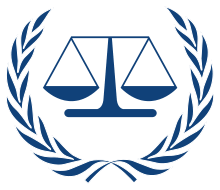Charter of the United Nations
The Charter of the United Nations (also known as the UN Charter) of 1945 is the foundational treaty of the United Nations, an intergovernmental organization.[1] The UN Charter articulates a commitment to uphold human rights and outlines a broad set of principles relating to achieving "higher standards of living", addressing "economic, social, health, and related problems" and "universal respect for, and observance of, human rights and fundamental freedoms for all without distinction as to race, sex, language, or religion."[2] As a charter, it is a constituent treaty, and all members are bound by its articles. Furthermore, Article 103 of the Charter states that obligations to the United Nations prevail over all other treaty obligations.[1][3]
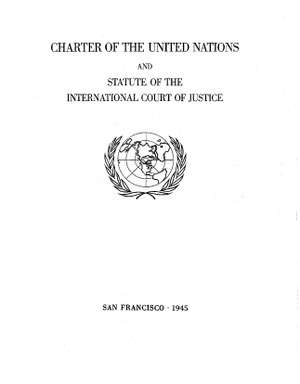 UN Charter | |
| Drafted | 14 August 1941 |
|---|---|
| Signed | 26 June 1945 |
| Location | San Francisco, California, United States |
| Effective | 24 October 1945 |
| Condition | Ratification by China, France, the Soviet Union, the United Kingdom, the United States and by a majority of the other signatory states. |
| Parties | 193 |
| Depositary | United States |
| Languages | Arabic, Chinese, English, French, Russian, and Spanish |
The Charter was discussed in detail during the San Francisco Conference starting on 25 April 1945, and was opened for signature on 26 June 1945.[4][5] It was signed at the San Francisco War Memorial and Performing Arts Center in San Francisco, United States, by 50 of the 51 original member countries (Poland, the other original member, which was not represented at the conference, signed it two months later).[4] In the meantime, the atomic bombings of Hiroshima and Nagasaki took place on 6 and 9 August, respectively; the introduction of this new weapon of warfare completely changed the security environment in which the UN Charter was promulgated.
The Charter entered into force on 24 October 1945, after being ratified by the original five permanent members of the United Nations Security Council—the China,[Note 1] the France,[Note 2] the Union of Soviet Socialist Republics,[Note 3] the United Kingdom, and the United States—and a majority of the other signatories. Most countries in the world have now ratified the Charter.
24 October was later declared as United Nations Day by the United Nations General Assembly.[6]
Summary
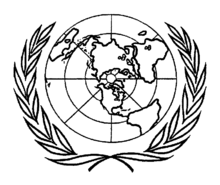
The Charter consists of a preamble and a series of articles grouped into chapters.[1]
The preamble consists of two principal parts. The first part contains a general call for the maintenance of peace and international security and respect for human rights. The second part of the preamble is a declaration in a contractual style that the governments of the peoples of the United Nations have agreed to the Charter and it is the first international document regarding human rights.
- Chapter I sets forth the purposes of the United Nations, including the important provisions of the maintenance of international peace and security.
- Chapter II defines the criteria for membership in the United Nations.
- Chapters III–XV, the bulk of the document, describe the organs and institutions of the UN and their respective powers.
- Chapters XVI and Chapter XVII describe arrangements for integrating the UN with established international law.
- Chapters XVIII and Chapter XIX provide for amendment and ratification of the Charter.
The following chapters deal with the enforcement powers of UN bodies:
- Chapter VI describes the Security Council's power to investigate and mediate disputes;
- Chapter VII describes the Security Council's power to authorize economic, diplomatic, and military sanctions, as well as the use of military force, to resolve disputes;
- Chapter VIII makes it possible for regional arrangements to maintain peace and security within their own region;
- Chapters IX and Chapter X describe the UN's powers for economic and social cooperation, and the Economic and Social Council that oversees these powers;
- Chapters XII and Chapter XIII describe the Trusteeship Council, which oversaw decolonization;
- Chapters XIV and Chapter XV establish the powers of, respectively, the International Court of Justice and the United Nations Secretariat.
- Chapters XVI through Chapter XIX deal respectively with XVI: miscellaneous provisions, XVII: transitional security arrangements related to World War II, XVIII: the charter amendment process, and XIX: ratification of the charter
Charter Provisions
Preamble
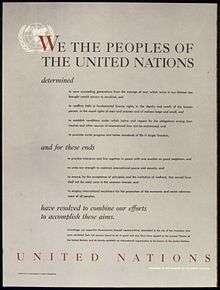
The Preamble to the treaty reads as follows:[7][8]
- WE THE PEOPLES OF THE UNITED NATIONS DETERMINED
- to save succeeding generations from the scourge of war, which twice in our lifetime has brought untold sorrow to mankind, and
- to reaffirm faith in fundamental human rights, in the dignity and worth of the human person, in the equal rights of men and women and of nations large and small, and
- to establish conditions under which justice and respect for the obligations arising from treaties and other sources of international law can be maintained, and
- to promote social progress and better standards of life in larger freedom,
- AND FOR THESE ENDS
- to practice tolerance and live together in peace with one another as good neighbours, and
- to unite our strength to maintain international peace and security, and
- to ensure, by the acceptance of principles and the institution of methods, that armed force shall not be used, save in the common interest, and
- to employ international machinery for the promotion of the economic and social advancement of all peoples,
- HAVE RESOLVED TO COMBINE OUR EFFORTS TO ACCOMPLISH THESE AIMS.
Accordingly, our respective Governments, through representatives assembled in the city of San Francisco, who have exhibited their full powers found to be in good and due form, have agreed to the present Charter of the United Nations and do hereby establish an international organization to be known as the United Nations.
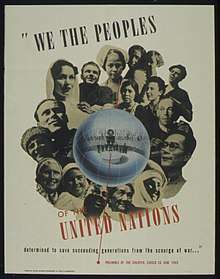
Although the Preamble is an integral part of the Charter, it does not set out any of the rights or obligations of member states; its purpose is to serve as an interpretative guide for the provisions of the Charter through the highlighting of some of the core motives of the founders of the organization.[9]
Chapter I: Purposes And Principles
Article 1
The Purposes of the United Nations are[1]
- To maintain international peace and security, to take effective collective measures for the prevention and removal of threats to the peace, and for the suppression of acts of aggression or other breaches of the peace, and to bring about by peaceful means, and in conformity with the principles of justice and international law, adjustment or settlement of international disputes or situations which might lead to a breach of the peace;
- To develop friendly relations among nations based on respect for the principle of equal rights and self-determination of peoples, and to take other appropriate measures to strengthen universal peace;
- To achieve international co-operation in solving international problems of an economic, social, cultural, or humanitarian character, and in promoting and encouraging respect for human rights and for fundamental freedoms for all without distinction as to race, sex, language, or religion; and
- To be a centre for harmonizing the actions of nations in the attainment of these common ends.
Article 2
The Organization and its Members, in pursuit of the Purposes stated in Article 1, shall act in accordance with the following Principles:[1]
- The Organization is based on the principle of the sovereign equality of all its Members.
- All Members, in order to ensure, to all of them the rights and benefits resulting from membership, shall fulfill in good faith the obligations assumed by them in accordance with the present Charter.
- All Members shall settle their international disputes by peaceful means in such a manner that international peace and security, and justice, are not endangered.
- All Members shall refrain in their international relations from the threat or use of force against the territorial integrity or political independence of any state, or in any other manner inconsistent with the Purposes of the United Nations.
- All Members shall give the United Nations every assistance in any action it takes in accordance with the present Charter, and shall refrain from giving assistance to any state against which the United Nations is taking preventive or enforcement action.
- The Organization shall ensure that states which are not Members of the United Nations act in accordance with these Principles so far as may be necessary for the maintenance of international peace and security.
- Nothing contained in the present Charter shall authorize the United Nations to intervene in matters which are essentially within the domestic jurisdiction of any state or shall require the Members to submit such matters to settlement under the present Charter; but this principle shall not prejudice the application of enforcement measures under Chapter VII of the United Nations Charter.[1]
Chapter II: Membership
Chapter II of the United Nations Charter deals with membership of the United Nations organization
Chapter III: Organs
- There are established as principal organs of the United Nations: a General Assembly, a Security Council, an Economic and Social Council, a Trusteeship Council, an International Court of Justice and a Secretariat.
- Such subsidiary organs as may be found necessary may be established in accordance with the present Charter.
Chapter IV: The General Assembly
Chapter V: The Security Council
COMPOSITION
Article 23
1. The Security Council shall consist of fifteen Members of the United Nations. The Republic of China, France, the Union of Soviet Socialist Republics, the United Kingdom of Great Britain and Northern Ireland, and the United States of America shall be permanent members of the Security Council. The General Assembly shall elect ten other Members of the United Nations to be non-permanent members of the Security Council, due regard being specially paid, in the first instance to the contribution of Members of the United Nations to the maintenance of international peace and security and to the other purposes of the Organization, and also to equitable geographical distribution.
2. The non-permanent members of the Security Council shall be elected for a term of two years. In the first election of the non-permanent members after the increase of the membership of the Security Council from eleven to fifteen, two of the four additional members shall be chosen for a term of one year. A retiring member shall not be eligible for immediate re-election.
3. Each member of the Security Council shall have one representative.
FUNCTIONS and POWERS
Article 24
1. In order to ensure prompt and effective action by the United Nations, its Members confer on the Security Council primary responsibility for the maintenance of international peace and security, and agree that in carrying out its duties under this responsibility the Security Council acts on their behalf.
2. In discharging these duties the Security Council shall act in accordance with the Purposes and Principles of the United Nations. The specific powers granted to the Security Council for the discharge of these duties are laid down in Chapters VI, VII, VIII, and XII.
3. The Security Council shall submit annual and, when necessary, special reports to the General Assembly for its consideration.
Article 25
The Members of the United Nations agree to accept and carry out the decisions of the Security Council in accordance with the present Charter.
Article 26
In order to promote the establishment and maintenance of international peace and security with the least diversion for armaments of the world's human and economic resources, the Security Council shall be responsible for formulating, with the assistance of the Military Staff Committee referred to in Article 47, plans to be submitted to the Members of the United Nations for the establishment of a system for the regulation of armaments.
VOTING
Article 27
1. Each member of the Security Council shall have one vote.
2. Decisions of the Security Council on procedural matters shall be made by an affirmative vote of nine members.
3. Decisions of the Security Council on all other matters shall be made by an affirmative vote of nine members including the concurring votes of the permanent members; provided that, in decisions under Chapter VI, and under paragraph 3 of Article 52, a party to a dispute shall abstain from voting.
PROCEDURE
Article 28
1. The Security Council shall be so organized as to be able to function continuously. Each member of the Security Council shall for this purpose be represented at all times at the seat of the Organization.
2. The Security Council shall hold periodic meetings at which each of its members may, if it so desires, be represented by a member of the government or by some other specially designated representative.
3. The Security Council may hold meetings at such places other than the seat of the Organization as in its judgment will best facilitate its work.
Article 29
The Security Council may establish such subsidiary organs as it deems necessary for the performance of its functions.
Article 30
The Security Council shall adopt its own rules of procedure, including the method of selecting its president.
Article 31
Any Member of the United Nations which is not a member of the Security Council may participate, without vote, in the discussion of any question brought before the Security Council whenever the latter considers that the interests of that Member are specially affected.
Article 32
Any Member of the United Nations which is not a member of the Security Council or any state which is not a Member of the United Nations, if it is a party to a dispute under consideration by the Security Council, shall be invited to participate, without vote, in the discussion relating to the dispute. The Security Council shall lay down such conditions as it deems just for the participation of a state which is not a Member of the United Nations.
Chapter VI: Pacific Settlement of Disputes
Chapter VII: Action with respect to Threats to the Peace, Breaches of the Peace, and Acts of Aggression
Chapter VIII: Regional Arrangements
Chapter IX: International Economic and Social Co-operation
Chapter X: The Economic and Social Council
Chapter XI: Declaration regarding Non-Self-Governing Territories
Chapter XII: International Trusteeship System
Chapter XIII: The Trusteeship Council
Chapter XIV: The International Court of Justice
Chapter XV: The Secretariat
- It comprises the Secretary-General and such other staff as the organization may require.
- It provides services to the other organs of the United Nations, such as the General Assembly, the S.C, the ECOSOC, and the trusteeship council, as well as their subsidiary bodies.
- The Secretary-General is appointed by the General Assembly on the recommendation of security council.
- The staff of the secretariat is appointed by the Secretary-General according to the regulations laid down by the General Assembly.
- The secretariat is located at the headquarters of the U.N in New York.
- The secretariat also includes the regional commission secretariat at Baghdad, Bangkok, Geneva and Santiago.
Functions of the Secretariat
- preparation of report and other documents containing information, analysis, historical background research finding, policy suggestions and so forth, to facilitate deliberations and decision making by other organs.
- to facilitate legislative organs and their subsidiary bodies.
- provision of meeting services for the General Assembly and other organs
- provision of editorial, translation and document reproduction services for the issuance of UN documents in different language.
- conduct of studies and provision of information to various member states in meeting challenge in various fields
- preparation of statistical publication, information bulletin and analytical work which the General Assembly has decided
- organization of conferences experts group meetings and seminar on topics of concern to the international community
- provision of technical assistance to develop countries.
- understanding of service mission to countries, areas or location as authorized by the General Assembly or the security
Chapter XVI: Miscellaneous Provisions
Chapter XVII: Transitional Security Arrangements
Chapter XVIII: Amendments
Chapter XIX: Ratification and Signature
| Wikisource has original text related to this article: |
Chapter XIX of the United Nations Charter deals with ratification and signature of the UN Charter. It provided that the Charter would enter into force once ratified by the Permanent Five members of the United Nations Security Council and a majority of the other signatory states. Ratification and Signatures are an important part of the United Nations.
See also
References
- "Introductory Note". Un.org. Archived from the original on 9 May 2005. Retrieved 9 February 2013.
- Christopher N.J. Roberts (June 2017). "William H. Fitzpatrick's Editorials on Human Rights (1949)". Quellen zur Geschichte der Menschenrechte [Sources on the History of Human Rights]. Human Rights Working Group in the 20th Century. Archived from the original on 7 November 2017. Retrieved 4 November 2017.
- "Chapter XVI: Miscellaneous Provisions". Archived from the original on 1 February 2013. Retrieved 29 June 2017.
- "1945: The San Francisco Conference". www.un.org. 26 August 2015. Retrieved 20 October 2019.
- "United Nations Conference on International Organization Proceedings". Hoover Institution. Retrieved 20 October 2019.
- United Nations General Assembly Session 2 Resolution 168. United Nations Day A/RES/168(II) 31 October 1947. Retrieved 24 October 2008.
- "Charter of the United Nations and Statue of the International Court of Justice" (PDF). Archived (PDF) from the original on 25 February 2018. Retrieved 17 February 2018.
- "Preamble". United Nations. Archived from the original on 18 February 2018. Retrieved 17 February 2018.
- Report of the Rapporteur of Commission I/1 UNICO VI, pp 446–7, Doc. 944 I/1/34(1).
External links
| Wikiquote has quotations related to: Charter of the United Nations |
- Full Text In the UN Website
- Scanned copy of the signed charter
- Original ratifications.
- Ratifications/admissions under Article IV.
- Alger Hiss recounts transporting the UN Charter after its signing.
- Procedural history note and audiovisual material on the Charter of the United Nations in the Historic Archives of the United Nations Audiovisual Library of International Law
- Declaration of Principles of International Law Concerning Friendly Relations and Cooperation Among States in Accordance with the Charter of the United Nations
- Lecture by Annebeth Rosenboom entitled Practical Aspects of Treaty Law: Treaty Registration under Article 102 of the Charter of the United Nations in the Lecture Series of the United Nations Audiovisual Library of International Law
- Christopher N.J. Roberts (June 2017). "William H. Fitzpatrick's Editorials on Human Rights (1949)". Quellen zur Geschichte der Menschenrechte [Sources on the History of Human Rights]. Human Rights Working Group in the 20th Century.
- After 1949, located in Taiwan; replaced on 25 October 1971 by the People's Republic of China
- Later replaced by the Fourth Republic and then the Fifth Republic.
- Replaced by the Russian Federation in 1991.
